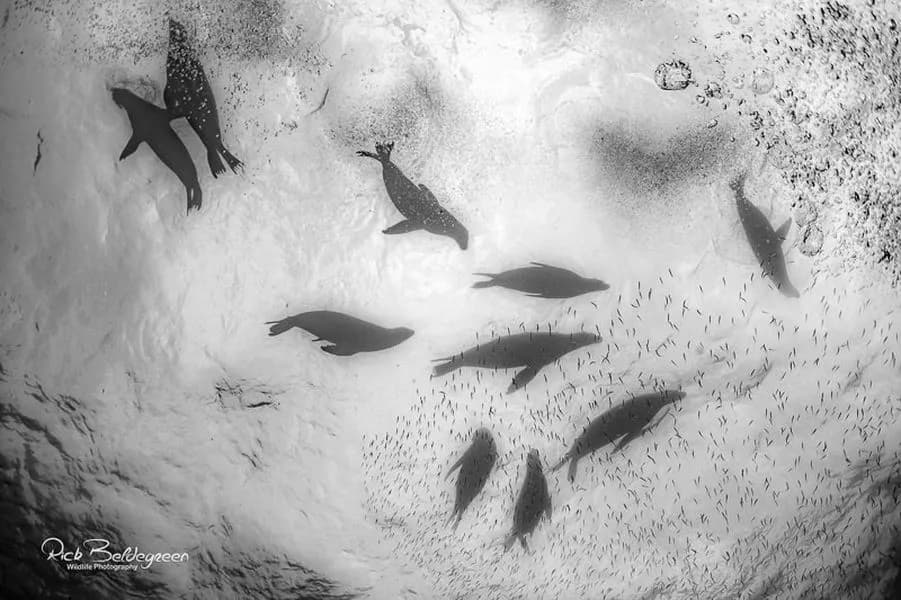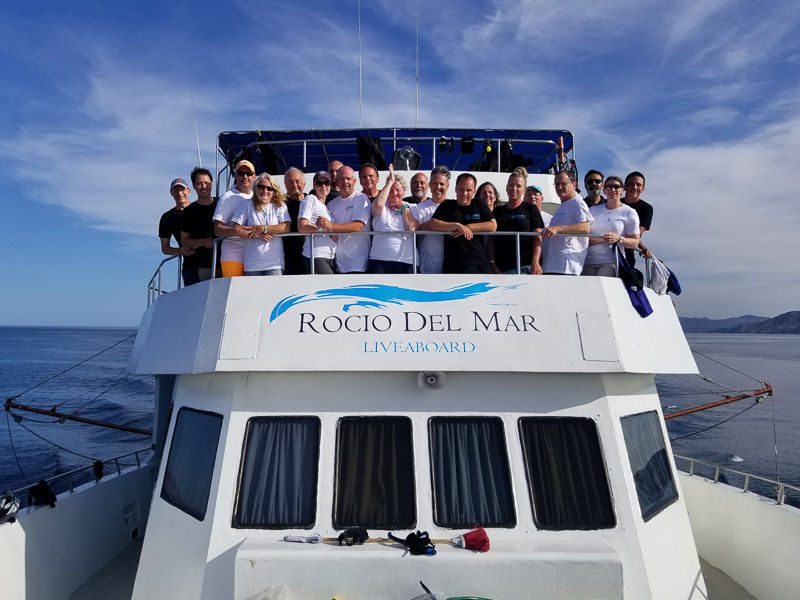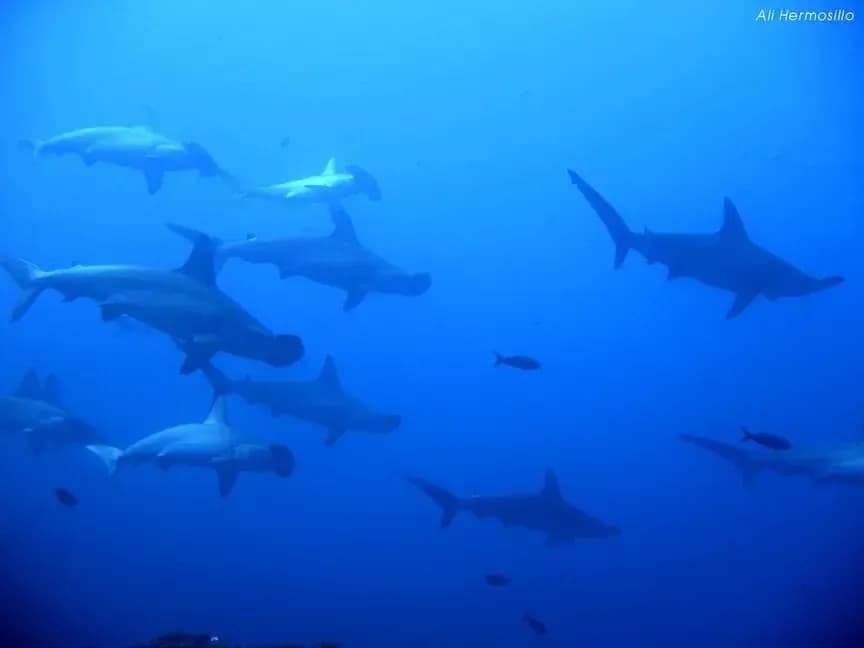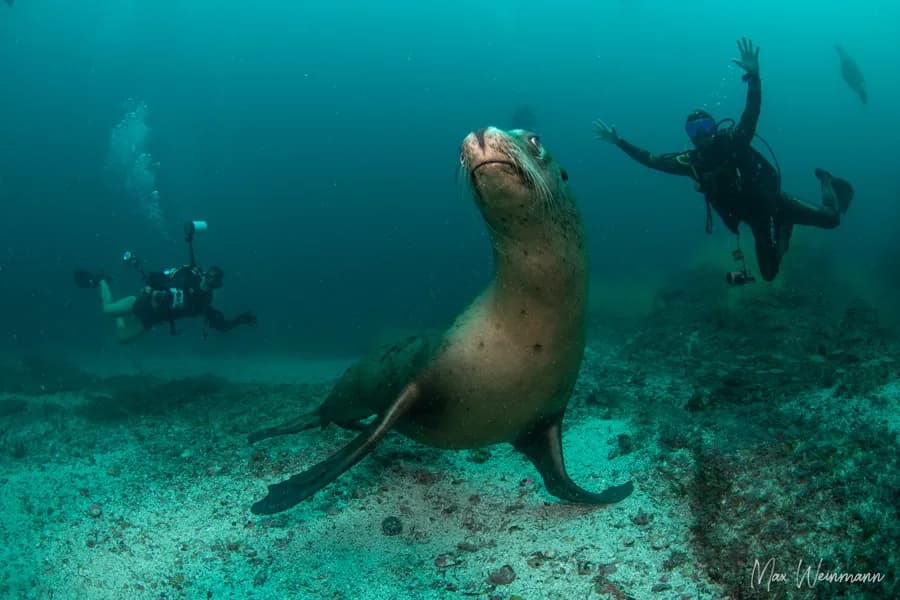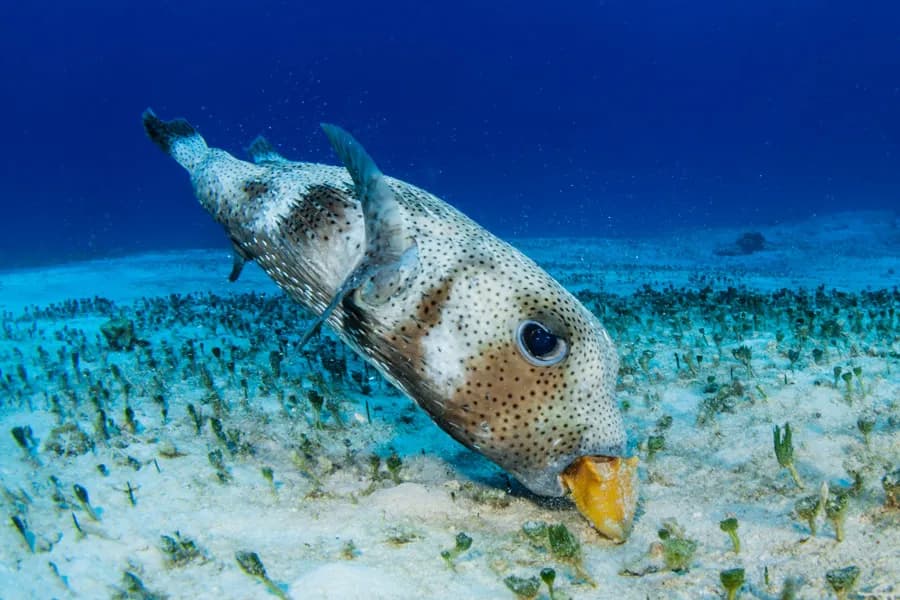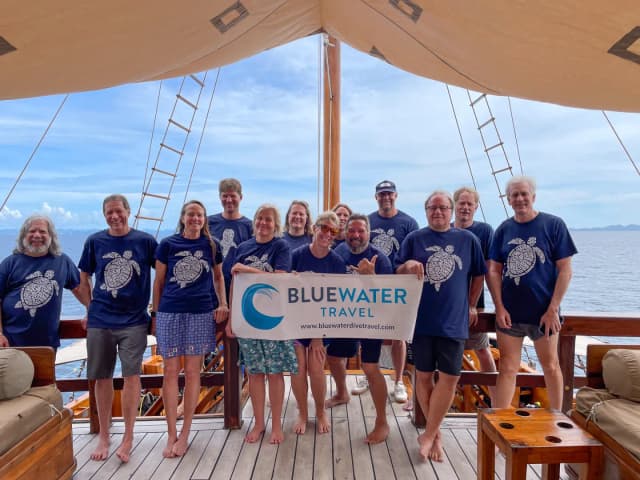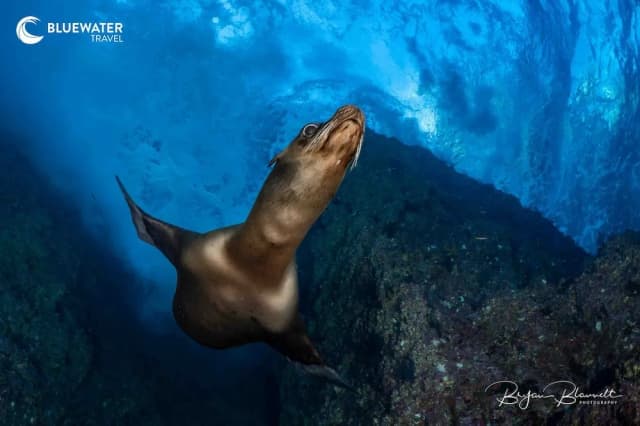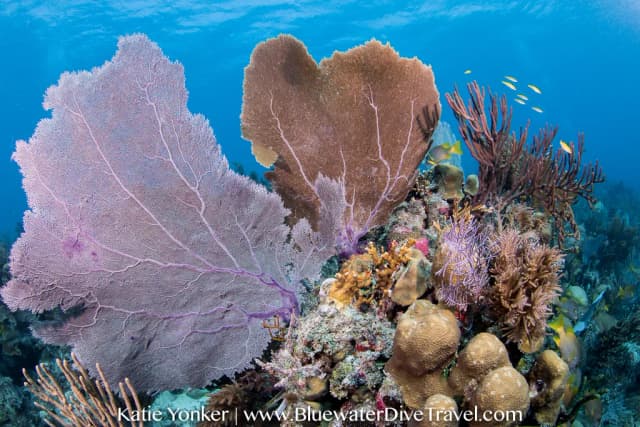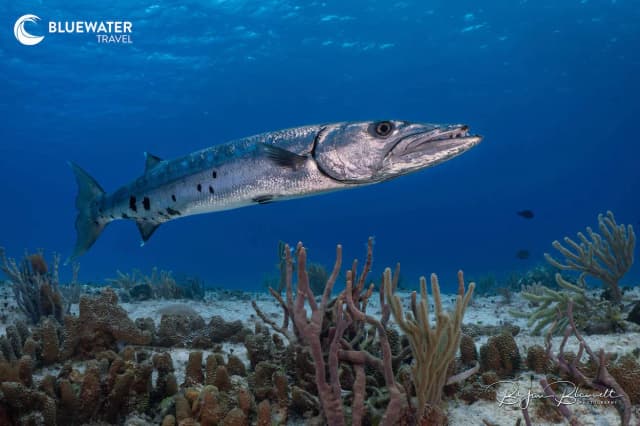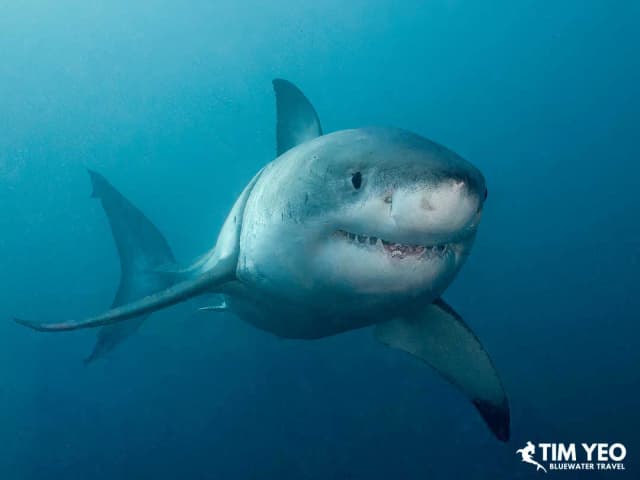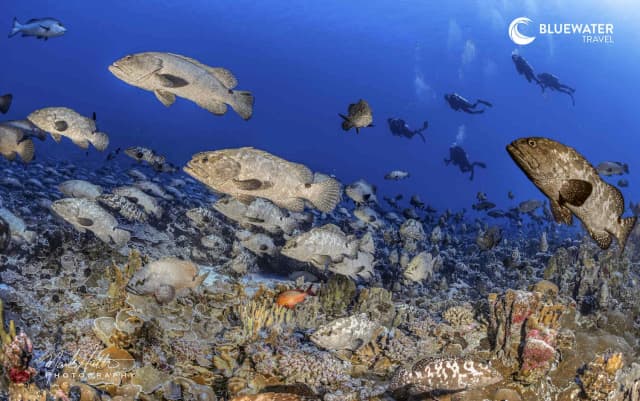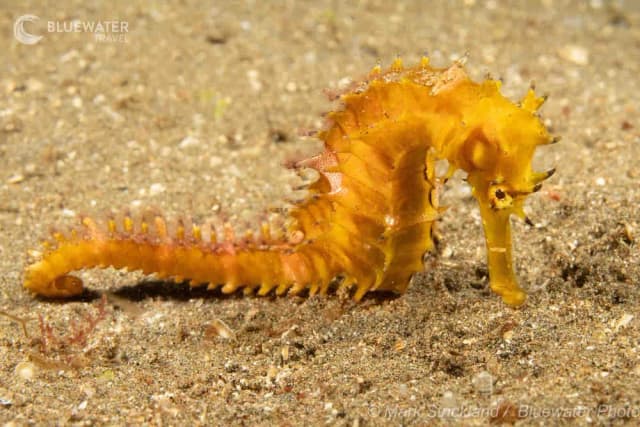Sea Of Cortez Trip Report - Jul 27 To Aug 3, 2019
Led by Bryan Chu| Photos by Bryan Chu and Group
The Sea of Cortez was where I first became hooked on underwater photography, at a Bluewater workshop 4 years ago. Since then I have learned quite a bit, and when Bluewater Travel asked me if I wanted to lead a trip there this year, it was a very easy decision: yes, of course!
The trip started with a flight to Phoenix, and then a 4-hour shuttle ride from the Phoenix Airport down to Puerto Penasco, Mexico. At the airport, as each of the 20 participants congregated by the pickup point, we accumulated a massive stack of dive gear and underwater photo equipment, the likes of which has probably never been seen before in Phoenix Airport (except for other Sea of Cortez trips, of course).
After a fairly straightforward border crossing, Mexican visas in hand, we boarded the boat around 5 pm, and as people settled into their rooms and set up their gear, we got underway.

The trip itinerary covers the Midriff Islands, basically the Northern half of the Sea of Cortez, with stops at a few different locations for a variety of macro and wide-angle shooting.
It was clear right from the start that the crew really knew what they were doing, and cared about making sure we had a great trip. The food was excellent throughout the trip, service was great, and they really took care of our gear and making sure we were safe and comfortable getting in the water, doing our diving, and getting back to the boat.
The Cameras
We had all kinds of cameras on this trip, ranging from GoPros and small Canon point & shoots up to large Nikon DSLRs. We also had a wide range of experience people who have done hundreds of dives and have been shooting for years, and people who were just getting started with underwater photography. Out of interest, heres the tally:
1x GoPro6
1x GroPro7 with video light
1x Canon G16
2x Canon G7X
1x Olympus TG-5
1x Sony RX100M2
1x Sony RX100M5
1x Sony A7III
2x Nikon D500

Morning dive briefing!
Day 1: Angel de la Guarda
After a bit of a rough crossing on the first night, we entered the sheltered waters around Isla Angel de la Guarda to start off our diving. The checkout dive landed us right onto some fun macro action: numerous male orange-throated pike blennies in their mating colors, flashing brightly as they popped in and out of their holes.

Male orange-throated pike blenny doing mating display. Olympus OM-D E-M1, 60mm macro lens, 2x YS-D1 strobes.
And once I slowed down and started looking carefully at the seemingly lifeless sand, it quickly became clear that it was, in fact, crawling with life. Sand-colored, partially transparent pike blennies were everywhere, some hovering over the sand, some backing into protective holes, some foraging for food, and others getting into small squabbles and territorial disputes with each other.

Fighting pike blennies. Olympus OM-D E-M1, 60mm macro lens, 2x YS-D1 strobes.
We were also on the lookout for the famed gulf signal blenny, which has an even cooler mating display than the orange-throated pike blenny. We found one on the first dive, which a few guests got to stake out to watch for its signature display.

Gulf signal blenny mating display, taken by Terry Keeney. Panasonic LX-100, YS-100 strobe.
After this nice checkout dive, we settled into a good macro rhythm, covering underwater photography fundamentals like lighting, focus, depth of field, and composition. And we began our first mantra of the trip: get low, get close, shoot up!
By the second dive, people were already taking off their wetsuits because the water temperature was so nice; 80 on the surface, maybe 78 at depth. I get cold easily so I kept my 3 mm on, and was more than comfortable. This dive was all about the blue spotted jawfish. There were males in non-mating colors tending to their holes, digging up the sand and popping out every now and then, maybe for a bite to eat.

Male blue-spotted jawfish spitting out sand, taken by Brian Cole. Olympus OM-D E-M1 II, 60mm macro lens, 2x YS-D1 strobes.
But the main attraction was the male blue-spotted jawfish in resplendent mating colors, popping up out of their holes 6 or more inches, and darting back in. Settling down on the sand to watch the jawfish everywhere, it soon became apparent that there were also a lot of very active orange-throated pike blennies in the area. So we all settled into our areas on the sand, trying our best to capture the cool behaviors of these very unique critters.

Male blue-spotted jawfish in mating colors, taken by Brian Cole. Olympus OM-D E-M1 II, 60mm macro lens, 2x YS-D1 strobes.
Day 2: Angel de la Guarda
By day 2, everyone from compact shooters to DSLRs was shooting in manual mode, adjusting shutter speed for the background exposure, aperture for depth of field, and strobes for foreground exposure. We had a great morning dive at La Vela, a wall/pinnacle with so many flabellina and tambja nudibranchs that I lost count (I only have 10 fingers, and couldnt use my toes).

Two flabellina nudibranchs, taken by Joe Holtz. Sony RX100V, diopter, 2x YS-D2 strobes.

Two tambja nudibranchs, taken by Rob Schick. Olympus OM-D E-M5 II, 60mm macro lens, 2x YS-D2 strobes.
We did our first image group image review, with people gaining inspiration and learning from each others great images. We talked a lot about what makes a great macro image: a great foreground and a great background, and people really worked hard to take shots of nice subjects with great backgrounds. Some experimented with black backgrounds, and most people worked on opening up their apertures to get nice blurry bokeh for their backgrounds.

This great image wowed everyone at our first image review, and set a trend of everyone looking to shoot fish on starfish, or other nice backgrounds. Taken by Chris Richard. Olympus OM-D E-M1 II, 60 mm macro lens, 2x YS-D1 strobes.
As the day went on, people dialed in their macro settings and composition, experimented with subjects and backgrounds, and came away with some very memorable and impressive images.

Nudibranch shot by James Durgin. Sony A7III, 50mm macro lens, 1x Ikelite strobe.

Christmas Tree Worm by Rainer Otto. Nikon D500, 2x Ikelite DS-161 strobes. Rainer received the unofficial award for the largest camera rig, which the crew took to calling the King Crab.

Anemone by Kenward Vaughan. Olympus OM-D E-M1 II, 60mm macro lens, 2x YS-D2 strobes.

Redhead goby with Christmas tree worms in background, by Chuck Brown. Sony RX100M2, diopter, 2x YS-110a strobes.

By experimenting with his lighting, Chris Patton was able to create this dramatic shot of a scorpion fish. Canon G7X II, 2x YS-D2 strobes.
Day 3: San Pedro Martir
After an overnight transit, we awoke to beautiful, flat water at the small island of San Pedro Martir. This was what most people came on this trip for: the legendarily cute and playful sea lions of the Sea of Cortez! We covered basic wide angle settings in the morning briefing, and people set up their wide angle rigs; fisheye lenses, wide angle zooms, and wet wide angle lenses everywhere. Once again, people took the plunge and shot manual, which is a more difficult affair with wide angle than with macro. Its not so bad if you do your test shots though, and I saw lots of test shots taken through the day!

This sea lion posed very nicely for Guy Shultz! Canon G7X II, dual strobes.
Some people took some great sea lion shots, while others had some issues getting them in focus and sharp (myself included), but regardless of the camera situation, everyone enjoyed diving with these incredibly playful cuties!

The sea lions liked to hang out together on the surface in between sessions of checking us out and playing with us. Photo by Rick Beldegreen. Nikon D500, 10-17mm fisheye lens.
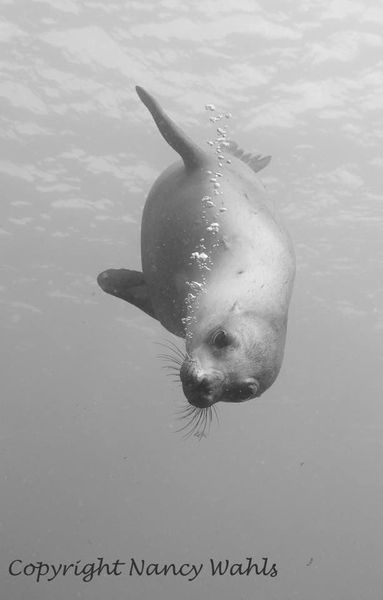
Sea lion photo by Nancy Wahls. Canon G16.
There were also some nice reefs to play around with wide angle reefscape scenes, and people tried out using dive models, as well as trying to bring the sun into their compositions.
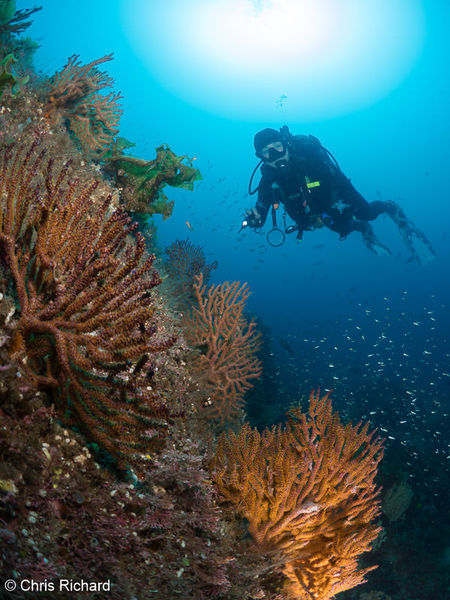
Reefscape by Chris Richard. Olympus OM-D E-M1 II, 2x YS-D1 strobes.

Reefscape. Olympus OM-D E-M1, 8mm fisheye lens, 2x YS-D1 strobes.
Day 4: San Pedro Martir
I don't think anyone was disappointed that the itinerary included two full days with the sea lions. In the morning, we talked about the challenges of photographing them; namely, they are really fast! We all tried to max out our shutter speeds, with many shooting at 1/250, 1/320 and 1/500 sec (depending on max shutter sync speed). One guest even turned off his strobes and shot at up to 1/800 sec on continuous burst mode!

Sea lion making bubbles. Olympus OM-D E-M1 II, 8mm fisheye lens. 1/800 sec, f/3.2, ISO 200.
The group I was with had some absolutely crazy sea lion action. The first dive of the day we had so many sea lions that people mostly ignored a very large, friendly, beautiful green sea turtle hanging around in the bay.

The neglected green sea turtle, taken by Guy Schultz. Canon G7X II, 2x strobes.
Meanwhile, on the second dive, we were bombarded by sea lions almost non-stop for the whole hour. It was enough time for me to really get my settings dialed in a get some fun shots.

Sea lion playing. Olympus OM-D E-M1, 8mm fisheye, 2x YS-D1 strobes.

Sea lion playing. Olympus OM-D E-M1, 8mm fisheye, 2x YS-D1 strobes.
We did two more dives with the sea lions, and continued to have memorable encounters. They were really active the whole time we were there, and I am sure I am not alone in having been pretty sad to leave their playful antics behind.
Day 5: Sal Si Puedes/Las Animas
For our second to last day of diving, we returned to macro shooting. The first couple of dives had a few nudibranchs, and lots of pretty blennies and gobies to shoot if a nice background could be found.

Pretty goby with a nice black background by Rainer Otto. Nikon D500, 2x Ikelite DS-161 strobes.

One of the runners up from the macro photo contest, Chuck captured this triplefin on a great background a brittle star encrusted sea fan. Sony RX100M2, 2x YS-110a strobes, diopter.

Brown cheeked blenny by Chris Richard. Olympus OM-D E-M1 II, 60mm macro lens, 2x YS-D1 strobes.

Rainbow scorpionfish by Christine Patton. Canon G7X II, 2x strobes.
Then our third dive of the day, at Caballo, we really hit the jackpot. This dive site is known for strong currents, so we could only dive it at slack tide, in the afternoon. Juan, our cruise director, told us that it was a really great macro site, and had been called nudi-palooza by previous guests. It did not disappoint. There were nudis crawling everywhere, including some massive tambjas, and some beautiful Spanish Shawls. There was also an octopus and a bunch of other cool stuff.
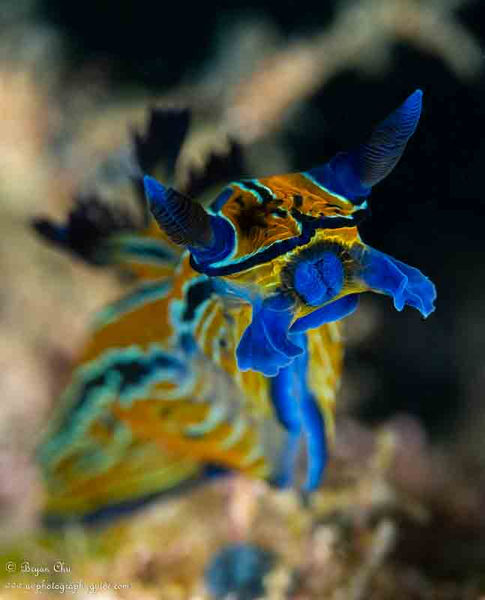
Tambja nudi face-on. Olympus OM-D E-M1, 60mm macro lens, 2x YS-D1 strobes.

Spanish shawl nudi. Olympus OM-D E-M1, 60mm macro lens, Nauticam CMC-1 diopter, 2x YS-D1 strobes.
Day 6: Baja California/Bahia de Los Angeles
The day started off with the final dive of the trip, a macro site with lots of colorful sponges, where frogfish could sometimes be found. Unfortunately, we did not see any, but one group did see 5 octopus! And the sponges made for beautiful backgrounds for macro images.

Blenny on a sponge by Rick Beldegreen. Nikon D500, 60mm macro lens, 2x YS-D2 strobes.

Octopus on the move by Terry Keeney. Panasonic LX-100, single strobe.
Then it was on to the final activity of the trip, swimming with the largest fish in the ocean! Bahia de Los Angeles is a bay with lots of whale shark food (ie plankton), meaning green waters and lots of whale sharks around. We went in 3 boats with 6 or 7 people each, plus a divemaster to help spot. The park rules only allowed four people from a boat in the water at a time, and other than maybe one other boat, we were the only boats in the whole bay.
So we had about 2.5 hours of time snorkeling with some pretty large whale sharks, with only 4 people in the water at a time definitely a big advantage over some of the busier/more popular whale shark locales! Every group had some time with a whale shark, and although it was very tiring work, it was a lot of fun.

Whale shark by Brian Cole. Olympus OM-D E-M1 II, 8mm fisheye lens, ambient light.

Whale shark by Brian Cole. Olympus OM-D E-M1 II, 8mm fisheye lens, ambient light.
Photo Contest!
After we finished up with the whale sharks, I sat down with the cruise director and one of the dive guides, and we judged all the entries for the photo contest. There was a macro division and a wide angle division, and both were extremely competitive. We had a very hard time choosing our favorites, but we whittled things down to a shortlist of 6 images in each category. Then we put the final judging to the workshop participants, who voted for their favourites. The amazing winning shots were:

First place wide angle by Rick Beldegreen. Nikon D500, 10-17mm fisheye lens, 2x YS-D2 strobes.

First place macro by James Durgin. Sony A7III, 50mm macro lens, Ikelite strobe
Along with winning the award for largest camera rig, guest Rainer Otto also won the award for most camera rigs, as he brought a second full-sized rig a camcorder in a housing, with a video light. All I can say is I am glad I did not have to carry a second rig with all of my stuff, as I have no idea how I would have fit it all! Rainer took some great footage and put together an awesome highlights video, which you can see here:
Final Thoughts
Overall, it was a great trip, with unique diving, lots of fun, and some learning along the way. We did a total of 19 dives, including 2 night dives, and also snorkeled with whale sharks. The crew was fantastic, the boat was great, and the weather was overall quite pleasant. I can say I would definitely like to return to the Sea of Cortez in the future, and if I do, I hope it is with a group as amazing as this one was!
For more information on trips to the Sea of Cortez as well as other amazing destinations email info@bluewaterdivetravel.com.
Join us on one of our other trips to the Sea of Cortez:
2024 & 2025
Explore Baja trips are similar itinerary but 12 nights instead of 7! Check out these trip dates as well:
2024 & 2025
